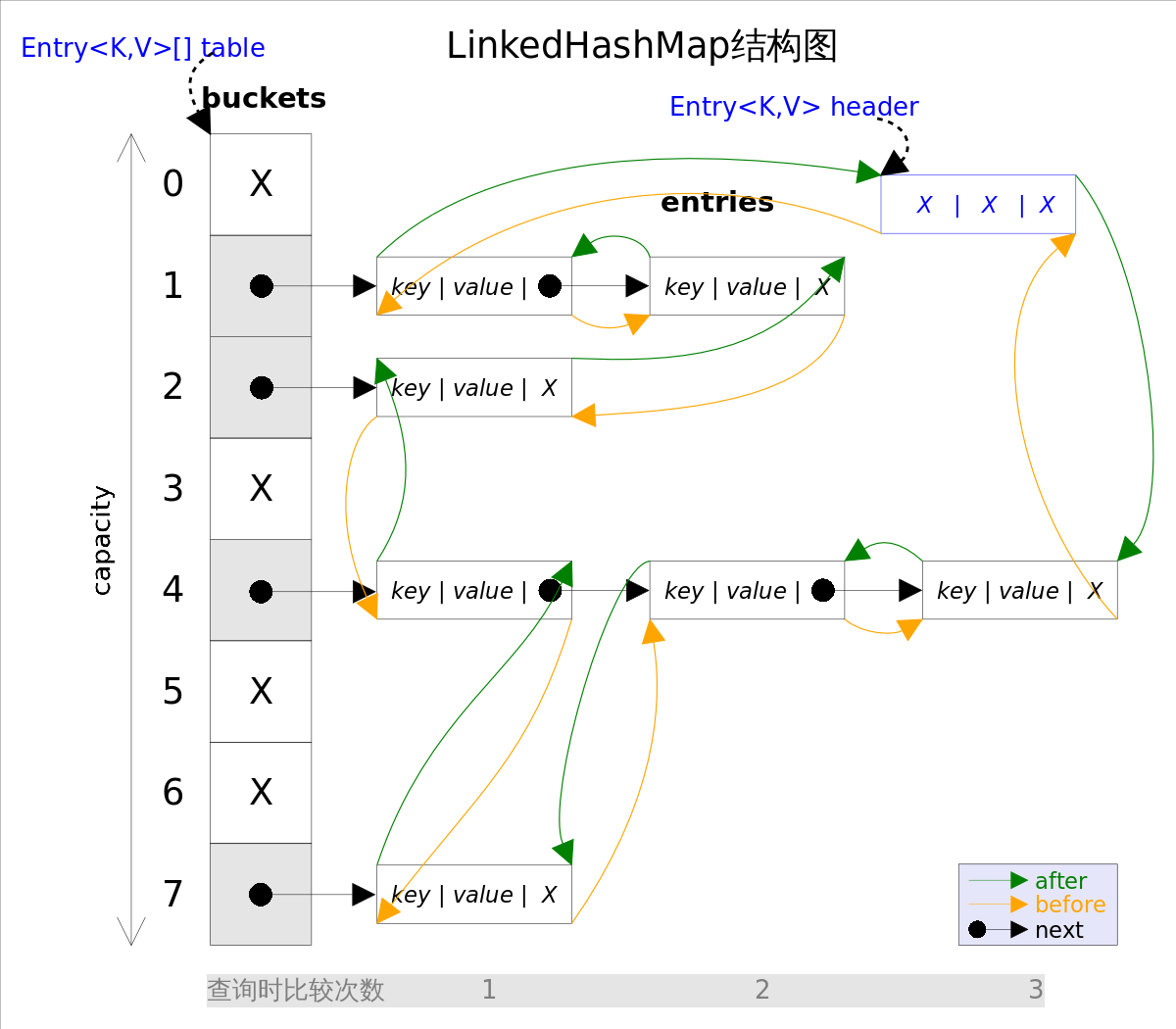Java集合--LinkedHashMap原始碼分析
概述
分析一下 LinkedHashMap 原始碼,看下內部結構,研究一下如何保證訪問順序。
繼承關係
public class LinkedHashMap<K,V> extends HashMap<K,V> implements Map<K,V>LinkedHashMap 繼承自 HashMap,是HashMap的一個子類。
內部結構
/** * HashMap.Node subclass for normal LinkedHashMap entries. */ static class Entry<K,V> extends HashMap.Node<K,V> { Entry<K,V> before, after; Entry(int hash, K key, V value, Node<K,V> next) { super(hash, key, value, next); } } private static final long serialVersionUID = 3801124242820219131L; /** * The head (eldest) of the doubly linked list. */ transient LinkedHashMap.Entry<K,V> head; /** * The tail (youngest) of the doubly linked list. */ transient LinkedHashMap.Entry<K,V> tail; /** * The iteration ordering method for this linked hash map: <tt>true</tt> * for access-order, <tt>false</tt> for insertion-order. * * @serial */ final boolean accessOrder;
Entry 類繼承自 HashMap.Node,增加了2個變數,before, after。來維護每個Node前面一個物件和後面一個物件。head, tail 變數維護連結串列頭和尾。accessOrder 為true表示按訪問順序來遍歷(訪問過的元素放到連結串列的尾部),為false表示按插入順序遍歷。
其實主要的內部結構還是和 HashMap 一樣的,只不過在HashMap的基礎上每個Node都加上了前後2個物件的引用。它的大致結構是這樣。

圖片來自網路
遍歷
遍歷一個LinkedHashMap,預設按照插入順序來顯示。結合 這篇文章 HashIterator
public Set<Map.Entry<K,V>> entrySet() { Set<Map.Entry<K,V>> es; return (es = entrySet) == null ? (entrySet = new LinkedEntrySet()) : es; } final class LinkedEntryIterator extends LinkedHashIterator implements Iterator<Map.Entry<K,V>> { public final Map.Entry<K,V> next() { return nextNode(); } } abstract class LinkedHashIterator { LinkedHashMap.Entry<K,V> next; LinkedHashMap.Entry<K,V> current; int expectedModCount; LinkedHashIterator() { next = head; expectedModCount = modCount; current = null; } final LinkedHashMap.Entry<K,V> nextNode() { LinkedHashMap.Entry<K,V> e = next; if (modCount != expectedModCount) throw new ConcurrentModificationException(); if (e == null) throw new NoSuchElementException(); current = e; next = e.after; return e; } ... }
原理和HashMap差不多,但是 LinkedHashMap 的遍歷(看nextNode方法)是從 head 開始遍歷,直到 Entry 的 after 欄位為空。
訪問順序
get 方法
public V get(Object key) {
Node<K,V> e;
if ((e = getNode(hash(key), key)) == null)
return null;
if (accessOrder)
afterNodeAccess(e);
return e.value;
}
void afterNodeAccess(Node<K,V> e) { // move node to last
LinkedHashMap.Entry<K,V> last;
if (accessOrder && (last = tail) != e) {
LinkedHashMap.Entry<K,V> p =
(LinkedHashMap.Entry<K,V>)e, b = p.before, a = p.after;
p.after = null;
if (b == null)
head = a;
else
b.after = a;
if (a != null)
a.before = b;
else
last = b;
if (last == null)
head = p;
else {
p.before = last;
last.after = p;
}
tail = p;
++modCount;
}
}get 方法和 HashMap 的基本一樣,但是多了一個 afterNodeAccess 方法,當 accessOrder 為 true 的時候執行這個方法,將訪問過的node放到連結串列的最後。
LinkedHashMap linkedHashMap = new LinkedHashMap(16, 0.75f , true);也就是像這樣初始化一個 LinkedHashMap 之後,每次訪問過一個物件之後這個物件就被放到了連結串列的最後。
put 方法
其實 LinkedHashMap 自己沒有實現 put 方法,還是呼叫的是 HashMap 的 put 方法
final V putVal(int hash, K key, V value, boolean onlyIfAbsent, boolean evict) {
Node<K,V>[] tab; Node<K,V> p; int n, i;
if ((tab = table) == null || (n = tab.length) == 0)
n = (tab = resize()).length;
if ((p = tab[i = (n - 1) & hash]) == null)
tab[i] = newNode(hash, key, value, null);
else {
Node<K,V> e; K k;
if (p.hash == hash &&
((k = p.key) == key || (key != null && key.equals(k))))
e = p;
else if (p instanceof TreeNode)
e = ((TreeNode<K,V>)p).putTreeVal(this, tab, hash, key, value);
else {
for (int binCount = 0; ; ++binCount) {
if ((e = p.next) == null) {
p.next = newNode(hash, key, value, null);
if (binCount >= TREEIFY_THRESHOLD - 1) // -1 for 1st
treeifyBin(tab, hash);
break;
}
if (e.hash == hash &&
((k = e.key) == key || (key != null && key.equals(k))))
break;
p = e;
}
}
if (e != null) { // existing mapping for key
V oldValue = e.value;
if (!onlyIfAbsent || oldValue == null)
e.value = value;
afterNodeAccess(e);
return oldValue;
}
}
++modCount;
if (++size > threshold)
resize();
afterNodeInsertion(evict);
return null;
}這裡有一個 newNode(hash, key, value, null),LinkedHashMap 重寫了這個方法
Node<K,V> newNode(int hash, K key, V value, Node<K,V> e) {
LinkedHashMap.Entry<K,V> p = new LinkedHashMap.Entry<K,V>(hash, key, value, e);
linkNodeLast(p);
return p;
}
// link at the end of list
private void linkNodeLast(LinkedHashMap.Entry<K,V> p) {
LinkedHashMap.Entry<K,V> last = tail;
tail = p;
if (last == null)
head = p;
else {
p.before = last;
last.after = p;
}
}由於Java多型的特性,put方法實際生成的是 LinkedHashMap.Entry 類,並且將這個node放到了整個連結串列的最後(linkNodeLast)。
remove 方法
LinkedHashMap 也是呼叫的 HashMap 的 remove 方法
final Node<K,V> removeNode(int hash, Object key, Object value, boolean matchValue, boolean movable) {
Node<K,V>[] tab; Node<K,V> p; int n, index;
if ((tab = table) != null && (n = tab.length) > 0 &&
(p = tab[index = (n - 1) & hash]) != null) {
Node<K,V> node = null, e; K k; V v;
if (p.hash == hash &&
((k = p.key) == key || (key != null && key.equals(k))))
node = p;
else if ((e = p.next) != null) {
if (p instanceof TreeNode)
node = ((TreeNode<K,V>)p).getTreeNode(hash, key);
else {
do {
if (e.hash == hash &&
((k = e.key) == key ||
(key != null && key.equals(k)))) {
node = e;
break;
}
p = e;
} while ((e = e.next) != null);
}
}
if (node != null && (!matchValue || (v = node.value) == value ||
(value != null && value.equals(v)))) {
if (node instanceof TreeNode)
((TreeNode<K,V>)node).removeTreeNode(this, tab, movable);
else if (node == p)
tab[index] = node.next;
else
p.next = node.next;
++modCount;
--size;
afterNodeRemoval(node);
return node;
}
}
return null;
}出方法前有一個 afterNodeRemoval(node) 方法,LinkedHashMap 重寫了這個方法
void afterNodeRemoval(Node<K,V> e) { // unlink
LinkedHashMap.Entry<K,V> p = (LinkedHashMap.Entry<K,V>)e, b = p.before, a = p.after;
p.before = p.after = null;
if (b == null)
head = a;
else
b.after = a;
if (a == null)
tail = b;
else
a.before = b;
}因為內部有一個連結串列,所以刪除的時候也要維護一下連結串列關係。
總結
LinkedHashMap 作為 HashMap 的子類,重寫了其中一些方法,擴充套件了 Node 類,使其具有了按順序遍歷資料的功能。在內部維護了一個連結串列,在put/remove方法中,在陣列中操作元素的同時,維護了一個連結串列。
